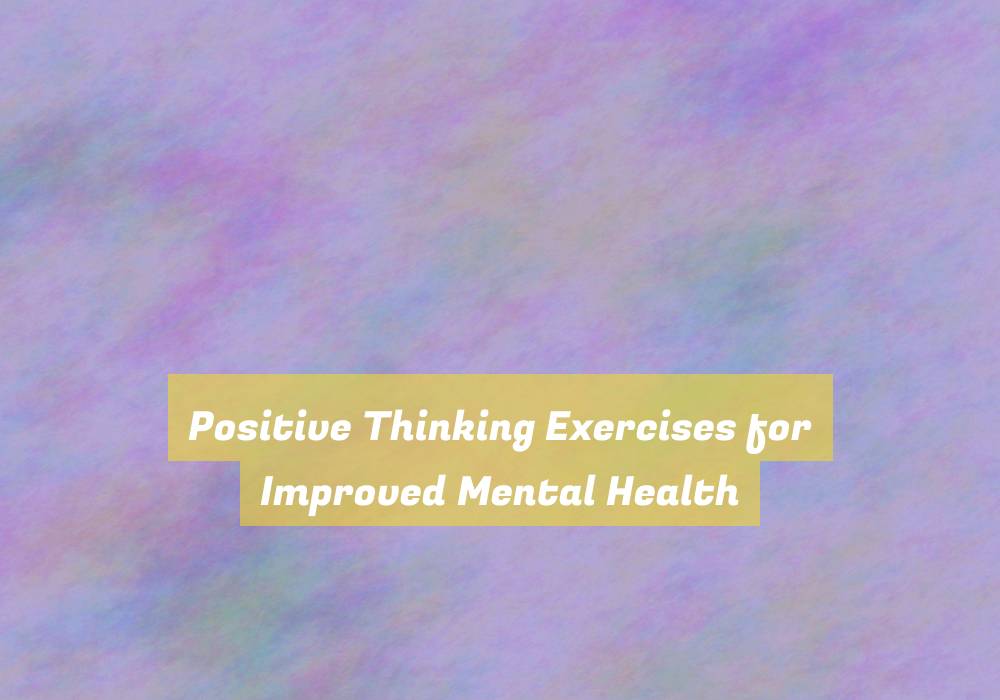Positive Thinking Exercises for Improved Mental Health
Feeling frazzled, frustrated, or fatigued? Finding ways to foster a more positive mindset can be a game-changer for your mental well-being. But where to start?
The power of positive thinking exercises can have a profound impact on your overall mental health and outlook on life. With practices like gratitude journaling, positive affirmations, visualization techniques, and mindfulness meditation, you can cultivate a more optimistic and resilient mindset.
But how exactly do these exercises work, and how can they benefit your mental health?
Gratitude Journaling
Start your day by jotting down three things youG??re grateful for in your gratitude journal. Take a few moments to reflect on the positive aspects of your life. It could be as simple as the sunshine streaming through your window, a kind gesture from a friend, or a delicious meal you enjoyed. By acknowledging and documenting these moments of gratitude, you can cultivate a more positive mindset.
When you consistently engage in gratitude journaling, you train your mind to focus on the good rather than the negative. This practice can help shift your perspective and attitude towards life, leading to increased happiness and contentment. Additionally, expressing gratitude has been linked to reduced stress and improved overall well-being.
As you write in your gratitude journal, take the time to truly savor the experiences and blessings youG??re thankful for. By doing so, you reinforce the positive emotions associated with these moments, deepening your appreciation for life. Over time, you may find that gratitude journaling becomes a cherished part of your daily routine, contributing to a more optimistic and fulfilling outlook.
Positive Affirmations
Engage in daily positive affirmations to rewire your mindset and cultivate a more optimistic outlook on life. Positive affirmations are powerful statements that can help challenge and overcome self-sabotaging and negative thoughts. By repeatedly practicing positive affirmations, you can shift your focus from whatG??s going wrong to whatG??s going right in your life.
Start by identifying areas where you want to improve your mindset, such as self-esteem, confidence, or overall happiness. Then, create concise, positive statements related to these areas. For example, if you want to boost your self-esteem, you might repeat the affirmation G??I am worthy and capableG?? several times a day. The key is to make these affirmations personal, present tense, and emotionally impactful.
ItG??s important to integrate these affirmations into your daily routine, whether itG??s saying them out loud in front of a mirror, writing them down in a journal, or incorporating them into your meditation practice. Over time, youG??ll notice a gradual shift in your thinking patterns as these positive affirmations become ingrained in your subconscious mind.
Visualization Techniques
To further enhance your positive mindset, incorporate visualization techniques into your daily routine to reinforce your optimistic outlook and manifest your goals. Visualization involves creating a mental image of a desired outcome or scenario. By vividly imagining yourself achieving your goals, you can boost your confidence and motivation.
Find a quiet space, close your eyes, and visualize yourself succeeding in your endeavors. Whether itG??s acing an interview, completing a project, or reaching a personal milestone, picture the scenario in detail, including the sights, sounds, and emotions youG??d experience. This practice helps program your subconscious mind to work towards turning your visualizations into reality.
Visualization can also be used to manage stress and anxiety. Imagine yourself in a peaceful, serene setting, and focus on the sensations of relaxation and calmness. This can help alleviate tension and promote a sense of tranquility. Additionally, athletes often use visualization to enhance their performance by mentally rehearsing their movements and strategies.
Incorporating visualization techniques into your daily routine can have a profound impact on your mental well-being and productivity. By consistently visualizing positive outcomes, you can cultivate a more optimistic and resilient mindset.
Mindfulness Meditation
Begin incorporating mindfulness meditation into your daily routine to foster a greater sense of present moment awareness and emotional balance. Mindfulness meditation involves paying attention to the present moment without judgment. Find a quiet space, sit or lie down comfortably, and focus on your breath. As thoughts arise, acknowledge them without getting caught up in them, then gently redirect your attention back to your breath. This practice can help you become more attuned to your thoughts and feelings, allowing you to respond to them in a calmer, more balanced way.
Regular mindfulness meditation can reduce stress, anxiety, and depression while improving your overall psychological well-being. It can also enhance your ability to concentrate and make decisions, as well as cultivate a greater sense of compassion and empathy. Start with just a few minutes each day and gradually increase the duration as you become more comfortable with the practice.
Set a reminder on your phone or incorporate it into your daily routine, such as before bed or upon waking. With consistent effort, you can experience the profound benefits of mindfulness meditation in your mental health and daily life.
Conclusion
Incorporating positive thinking exercises into your daily routine can lead to improved mental health. By practicing gratitude journaling, positive affirmations, visualization techniques, and mindfulness meditation, you can cultivate a more optimistic mindset and reduce stress.
These exercises can help shift your focus from negative thoughts to positive ones, ultimately leading to a happier and more fulfilling life.
So, start incorporating these exercises into your daily routine and watch as your mental health improves.



